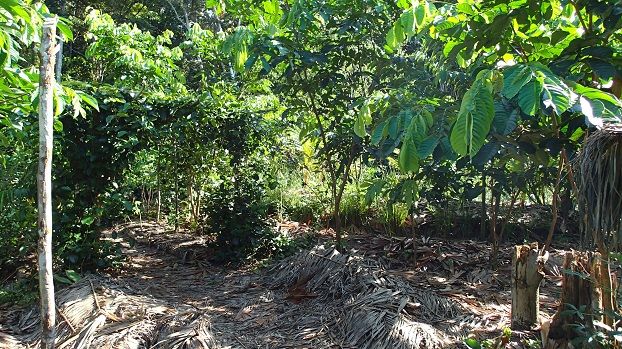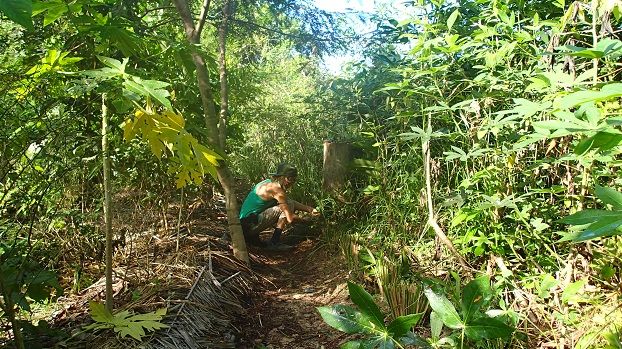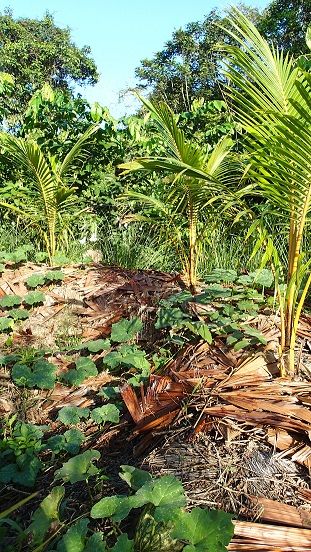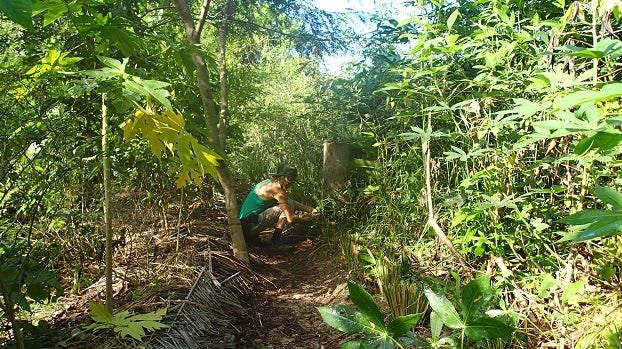Since last year, we have been continuing to develop this 1 hectare forest clearing into a fully functioning Permaculture demonstration site. Our aim is to produce food, medicines and fuel from this site; experimenting with various methods, from polycultures to nutrient cycling, so that we can harvest the abundance. In this blog I want to share some of the lessons we have learnt over the past year.

Firstly, by concentrating our efforts last year in designing and implementing a long term mainframe system we have been able to keep our nutrition on the land, allowing a good layer of humus to build up. Over the year we have also been adding old palm thatch from our healing centre roofs, forest leaves and biochar, in a technique called sheet mulching. You add layers of organic materials so that they can break down into soil, whilst suppressing competition for your planted plants. In this humid tropic climate, of heavy downpours and intense sun, it also protects the soil and its life.
Last year we chose certain plants to be chopped and dropped into the soil, and so in the long term not require any inputs from outside the land. Throughout the system we have healthy vetiver grass (Chrysopogon zizanioides), pigeon peas, leucaena and ice cream beans, which also fix nitrogen into the soil, so we can continue to produce soil. In the dry season we allowed the ice cream beans to grow so that we could bring more shade to the soil and plants that would otherwise not thrive in the intense sun periods. Here, one of the interns is chopping and dropping the vetiver on the shady swale pathway.

You can see, throughout our swales we have healthy papayas, yucca and peppers.
Through building the soil in this way, it has allowed us to experiment with different planting systems. We have trialed various polyculture mixes so that we can learn what will work into the future.
Everyday we offer guests in our healing centre floral baths, therefore we have a great need for fresh scented cuttings to prepare these. In the Shipibo tradition there is specific mix, we have been growing Rosa Sisa/Marigold, Albaca/Wild Basil and Lenguo de Perro/Tongue of the Dog this year. Through research and practical experience we have found that these aromatic plants are extremely useful planted with other productive crops. We have seen that they bring in beneficial insects that will pollinate, or prey on other insects that may eat your other crops. They are great protectors to have in the garden, and by pruning to prolong their lives, we are able to use their aromas for our own health in our floral baths. Therefore, we have these planted throughout the forest garden.

In between this basic system we are experimenting we other crops, from sugar cane, pineapples, passion fruits and cocona (Solanum sessiliflorum), as in the system to the right.
In every system we implement we make sure to add layers of vegetation, replicating the forest we see around us. Below left is dryland Taro, cocona, sweet potato and beans. Below right is a mix of florals, mapacho (Nicotiana rustica), papaya, pepper and moringa (Moringa oleifera).
In general, we have found that the local varieties of plants with even little care and attention always do the best here, here’s a local tobacco and another local Solanum family plant, known as coconilla here.
On top of the hill we designed a food forest, with a coconut circle center and medicinal edge, to drop down nutrients into our other systems. To finish this update here is a picture of our 1-year old coconuts surrounded by pigeon pea and vetiver with a ground cover of squash.

